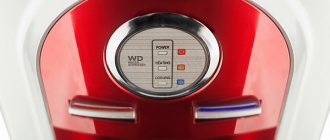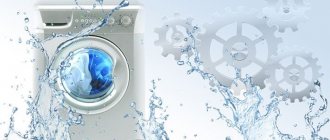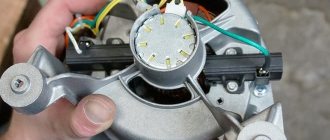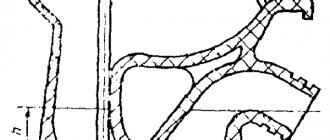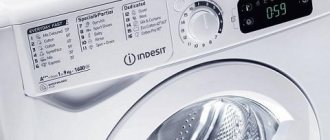What is responsible for draining water in a washing machine?
Before understanding the possible reasons, it is worth clarifying which mechanisms in the washing machine are responsible for draining the water. So, the water pump rules the show, which is essentially a kind of engine with an impeller. This “monster” (more precisely, its motor) rotates, which forces the water to move down and leave the washing machine through hoses and pipes into the sewer.
It would seem that what else, besides the pump (or, in other words, the pump) could be the cause of the malfunction? The pump itself has stopped working, and as a result the water does not flow out. No, such a superficial analysis is not for us. There can be many more reasons for the breakdown. And we will analyze the most common of them in this material.
The washing machine does not drain water, what should I do?
After finishing washing, do you find that your laundry is wet, or even worse, there is still water in the drum? Are you at a loss as to what could have happened, why did the washing machine stop draining water and spinning clothes? And what should we do about it? In this article we will analyze all possible malfunctions, and fix some of them ourselves.
- The main causes of water drainage malfunctions
- Do-it-yourself troubleshooting
- Cleaning the filter
- Inspection of the pipe
- Checking the impeller
- How to check the pump for malfunction and replace it?
- Electrical wiring fault
- Faulty water level sensor (pressostat)
- The control module (programmer) is faulty
- Conclusion
The main causes of water drainage malfunctions
If the water does not drain in the washing machine, the reasons for this problem may be the following:
- The connecting pipe, which is located between the pump and the tank, is clogged with debris.
- A foreign object has entered the drain pump.
- Debris has accumulated in the pump filter.
- The pump itself has failed.
- The drain hose is clogged.
- Problems with the sewer or siphon.
- The water level sensor (pressostat) is not functioning.
- The control module (programmer) is malfunctioning.
Having learned the reasons that influence the correct spinning and draining, you can begin to inspect and repair the machine, but before you start, you must turn off the power.
Do-it-yourself troubleshooting
Cleaning the filter
To prevent the filter from becoming clogged, which may cause the washing machine to not drain, it must be checked and cleaned as appropriate. You can find it on the front side of the unit, at the bottom of the body. There you will see a hidden panel, which is closed with latches. You can open it with a regular flat-head screwdriver. Open the panel carefully; a screwdriver can easily break the latches. After opening the panel, you should see a filter that unscrews counterclockwise. If you cannot unscrew the filter by hand, you can use pliers.
Due to the blockage, you need to be prepared for some amount of liquid. It’s better to prepare in advance; a rag and any container will be useful for this.
When you unscrew the filter and find that it is really clogged, the problem can be called solved. Just clean it of any debris and screw it into place.
Inspection of the pipe
If cleaning the filter does not produce results, then you need to continue the repair and begin inspecting the pipe. A pipe is a hose that connects the tank and the pump; accordingly, if it becomes clogged, the machine does not drain the water and does not spin out the laundry. The outlet from the tank may also become clogged; a pipe is connected to it; a foreign object may get stuck in this hole; it may also obstruct the passage of liquid.
To clean the pipe from foreign objects, you need to find the bolts on the back side and unscrew them. Next, the hose is removed; first you need to get rid of the clamps using pliers.
To check whether there is dirt in it or not, you can feel it by squeezing it in your hands. If there is debris, it must be eliminated. This can be done under the pressure of running water, using an ordinary brush or rag. Once the pipe has been cleaned, it should be reinstalled in its original location following the above procedure, in reverse order.
After installing the pipe in place, make sure that the clamps press the connection well to avoid leaks!
Checking the impeller
What to do if the previous methods did not solve the problem?
The malfunction may lie in a faulty condition of the impeller. In order to make sure of this, you need to check it for jamming. Also, its malfunction may be indicated by free scrolling; if the impeller is working properly, it should turn in small jerks. It is located on the front of the pump, immediately behind the filter. A malfunction can occur when, during operation of the impeller, some foreign object, such as a coin or a match, prevents it from spinning. Because of this, the pump in the washing machine usually hums, as there is a load on its motor winding. First, it is better to check it manually, trying to turn it with your fingers. If a foreign object is visible when scrolling, it should be removed. After these manipulations, the machine still does not spin out the laundry? Then it's time to start inspecting the pump.
Pump impeller
How to check the pump for malfunction and replace it?
The reason why the drain in the washing machine does not work may lie in a faulty pump. In order to find out, you need to remove the filter as described above. After that, set the spin program and look at the place where the filter was. To see well, you need to provide good lighting, for example, shine a flashlight there. If you see that the pump impeller remains motionless, this means that the drain pump is faulty. Otherwise, the impeller would rotate, since it had already been checked for the presence of foreign objects. There is also another method of checking, for this you need a tester or otherwise a multimeter. With its help, you can check the integrity of the winding; to do this, you need to ring it. When a pump breaks down, it is often simply replaced with a new one, since its repair is complicated and will cost half its price. Most often, they simply burn out due to the heavy load that occurs when the impeller jams.
Drain pump (pump)
It won’t be difficult to purchase one; there are standard pumps on sale that fit almost any model of washing machine: Samsung, Lg, Indesit, Ariston and others.
After a new pump has been purchased, it should be installed in place of the broken one. To replace it you only need a screwdriver and pliers. The procedure is quite simple:
- First, drain all the liquid from the machine.
- For convenience, place the machine on its side.
- Then remove the drain assembly itself.
- Unfasten the pump that is causing the machine to not pump out water. It is connected with screws, usually 3.
- Take your time to disconnect its contacts.
- Mount the prepared new pump in the vacant space.
- Connect the contacts, usually there are only two. Don't worry if you mix up the wires, because no matter how you connect them, you can mark them to be on the safe side.
- Reassemble the car to its original condition.
Electrical wiring fault
Sometimes it may happen that after all the methods described above, the malfunction remains. In this case, you should use the emergency drain of water from the washing machine and thoroughly check the electrical wiring.
The reasons may be the following:
1.A short circuit has occurred. Usually occurs when exposed wires come into contact.
2. The contacts just came off the drain pump. You need to see if the contacts are pressed tightly.
3. The microcircuit on the control board has burned out, which is why there is no signal to the pump.
It is safer to check the wires for integrity and absence of moisture before installing the pump in place. Important! Before any work with equipment, you need to make sure there is no voltage. It is best to entrust such work to specialists.
Faulty water level sensor (pressostat)
Another problem due to which the water cannot drain may be a faulty operation of the pressure switch.
The principle of its operation is designed in such a way that when water is drawn into the tank, the pressure increases, which through a special rubber tube approaches the sensor, thereby reacting to the pressure, regulating the water level. It and the pump are closely connected to the control module; when the liquid in the tank reaches a certain level, the sensor is triggered and thereby sends a signal to the control board, after which the water supply stops. So this sensor can simulate a signal that the liquid has been drained, and the module will therefore not send a signal to the pump to drain the water.
To make sure the sensor is working properly, you need to get to it and carry out a couple of manipulations. This sensor is usually located on top of the unit, just under the top cover.
Unscrew a couple of bolts from the back and slide the cover away from you, then lift it up. Once you get to the sensor, you will need to remove the tube connected to it and blow into it. A working pressure switch should click when air is blown into it, but if there are no clicks, this clearly indicates a breakdown of the sensor.
The control module (programmer) is faulty
In modern washing machines, special boards are installed, they are called modules. They are usually located at the front of the unit. This board can be called the brain of the washing machine; it carries out various programmed commands, and the spin program is no exception, in which a signal is sent to the pump so that the drain works. Although the parts of such a board are protected from moisture and are not subject to corrosion, there is a possibility that some kind of microcircuit, for example a diode or resistor, may burn out, or the firmware may also come loose. Repairing such a board is quite labor-intensive, and therefore it is easier to replace it entirely. It is better to leave it to specialists to replace or repair the module.
Conclusion
To avoid a high probability of breakdowns of this kind, you need to carry out monthly maintenance. Such preventive measures include:
- Regardless of how many times the machine is started, you need to check and clean the filter at least once a month. If the equipment is used daily, it is better to check it twice a month.
- In order for the machine to spin clothes efficiently, you must load laundry according to the instructions.
- Before you start washing, you must make sure that there are no malfunctions, and only then load things into it.
Perhaps the problem is in the software module?
In our age of computer technology, one cannot help but blame the technology for an ordinary software error, even if there was none. Yes, indeed, sometimes it happens that water does not drain in a Samsung washing machine (and other companies, by the way, too) precisely because of an ordinary software error.
But even in this case, you should not delude yourself that the problem is trivial and can be easily solved. If the software module starts to make errors, it may happen that it is ready to fail, or some contacts are not working well, which causes errors. Be that as it may, you need to check the software module for errors and, of course, functionality.
However, it is still worth trying to correct the situation. You just need to try to restart the spin cycle, and if everything works out, then the owners have nothing to worry about: a one-time error has occurred, which is not worth paying attention to.
If the machine still refuses to drain the water, the problem is obvious, and it already needs to be fixed - either call a technician, or take the Samsung machine to a technician yourself. Fortunately, cars of famous brands are repaired everywhere, and components for them are supplied to most service centers.
Or is the problem in the drain filter?
It is far from certain that the cause of the malfunction lies in the software module. There is a high probability that the root of evil should be looked for at the bottom of the washing machine - in the drain filter. The fact is that any machine will not drain the water if the drain filter is clogged, so as not to aggravate the situation: what if some small items are hidden among the things being washed? Well, or even not so necessary. By the way, most often the machine does not drain water precisely because the drain filter is clogged.
Fixing this problem is very, very easy. You just need to unscrew the drain filter (usually it is located at the bottom of the washing machine, on the right or left under the panel), clean it and return it to its place. Before the operation, it would be useful to place some container under the filter hole, since water may flow out. ATTENTION! This operation cannot be performed if there is liquid in the machine tank! There is a high probability that the entire flow of water will rush through the hole that appears.
The washing machine does not drain water - what should I do?
If, at the end of the specified mode, the machine does not drain the water and hums, then a malfunction of the drain mechanism has occurred.
The problem with draining the water does not allow the wash to be fully completed - the program stops and the laundry loading hatch is blocked. There is water behind the glass door of the washing machine.
There are several possible reasons for a drain failure.
Reasons why the washing machine does not drain water
The drain mechanism of the machine is extremely simple. A pump and a drain hose connected to the sewer are responsible for draining the water.
When starting, the machine draws water. After the wash is completed, water from the drum passes through a corrugated tube with a filter, then enters a pump, which, under pressure, pushes the liquid into the drain hose.
If the washing machine does not drain water, the reasons may be as follows:
- hose clogged;
- incorrect choice of washing program;
- breakdown of the pump or other part.
Most of the faults that cause the drain to not work depend on the service life of the machine and the operating characteristics.
Blockage
A common reason for a washing machine not draining is a clog.
Clogging occurs when pins, nails and coins from clothing pockets get into the washing drum. Fallen objects are washed out along with waste water.
Modern machines have a protective strainer installed at the drum outlet. Debris does not pass through the fine mesh of the mesh, so it gets stuck in the filter.
Small fibers of fabric, threads, hair, and animal fur from clothing can even pass through the filter mesh. In this case, the clog clogs the drain hose, so the washer cannot drain the water.
The machine can become clogged and stop draining liquid due to time of use or the carelessness of the owner.
Wrong program selection
The machine will not drain water if the non-draining washing mode is selected.
Spinning and delicate washing, for example, do not use the drain mechanism. To drain the water, you need to install this program manually.
In most washing machine models, the pump will not pump out water in hand wash mode.
To select the correct washing program, the housewife should study the instructions describing the features of each mode.
Damage to the pump or other parts
Long service life, blockages and hard water can damage the drain pump. A faulty pump will hum constantly or stop turning on.
Damage to the electric pump can be caused by running without water. This usually happens when the impeller jams. The part with the blades is located inside the pump. The impeller rotates, converting energy from the motor into pressure to mix the liquid. Stuck threads or hair block the impeller blades, and it stops turning water in the washer. As a result, the pump runs dry and burns out.
The electronic control board may break. The cause of its malfunction is usually a short circuit. A power surge causes capacitors and microcircuit wire contacts to burn out.
Troubleshooting
To find out why the washing machine does not drain water, you need to check the unit according to several parameters. The time spent searching for the causes of the malfunction is compensated by saving money on calling a technician.
How to drain the water
To empty the drum, prepare a container to catch the escaping liquid.
You can drain the water through:
- drain filter;
- drain hose;
- emergency drain pipe;
- laundry loading hatch.
It is better to start with the emergency tube, which is located in front of the drain filter. You need to open the small hatch and lower the tube down. Not every washing machine has a tube.
If there is no tube, go to the drain filter. For washing machines of different brands, the drain filter is located in different places. The part may be located behind the hatch on the front panel of the machine or under the body of the unit. The structural features of a specific model are described in the instructions.
In the first case, you need to open the square door, unscrew the screw and pull out the filter. The second option is more complicated: before removing the filter, you will have to remove the bottom.
The next step is draining through a hose. Usually the pipe is attached vertically to the body of the washing machine. Loosen the fastening clamps and lower the hose into a water collection container or bathtub.
If gentle methods do not work, you can drain the water through the laundry hatch. To do this, turn off the washing mode and wait a couple of minutes until the door unlocks. Then open the hatch and be prepared for water to flow onto the floor.
Removing blockages
If the problem is a clogged filter or drain hose, you will need to disconnect them from the machine body.
To clean the filter, you need to follow the following sequence of actions:
- press or unlatch the door;
- unscrew the fastening bolt;
- carefully remove the filter, perhaps by picking up the part with a knife or flat screwdriver;
- hold the filter under water pressure.
After cleaning the filter, move on to the drain pipe. The hose must be removed and the following done:
- push through the blockage with a wire or metal cable;
- pour in pipe cleaner and leave for 10 minutes;
- rinse the hose under high water pressure;
- put the pipe in place.
Having freed the drain mechanism from blockages, start the wash again and check whether the water flows out.
Reset programs
To eliminate a program error, you must reset the set washing mode. To do this, touch the power sensor or press the start button on the panel.
If pressing once does not work, the button should be held down for several seconds.
Do not unplug the power cord from the outlet. This will not solve the problem: when you turn it back on, the machine will resume the interrupted program.
Turning off the power during the washing process may damage the control board.
More serious problems with the drain filter
If the owners did not pay enough attention to the “health” of their washing machine, the drain filter may not only become clogged, but also fail. For example, the gaskets may rot, and as a result, the screws may rust and begin to fall apart (not available on all models of Samsung washing machines), which can be fatal. Be that as it may, a faulty drain filter needs to be replaced.
When replacing, you should pay attention to the gaskets: it will be better to replace them together with the filter: this is not very expensive, and practical, and can help get rid of similar malfunctions in the future.
What to do?
If consumer errors are excluded, you can move on to analyzing the operation of the nodes. It is better to do this in the following order: start with the most accessible ones, leaving the most difficult ones for later.
Preliminary preparation of the machine:
- if there is water in the washing machine, it must be drained (naturally or through an emergency drain);
- disconnect the washing machine from the power supply;
- shut off the water supply to the device;
- pull out the washing machine in such a way as to provide convenient access to its rear wall;
- pull out the powder receptacle.
Drain violation
If the washing machine does not drain the water, it cannot proceed to the spin cycle. In this case, it is necessary to gradually sort through all possible problems associated with the drain.
It’s better to start by cleaning the drain filter, since even if the problem is not there, regular cleaning of this unit will benefit the car.
Next, it is necessary to diagnose the operation of the drain pump and check the permeability of all systems associated with draining water.
The drive belt has expired
If the drive belt is stretched, it does not provide the necessary contact with surfaces. If it “slips,” the part must be replaced, since it cannot be repaired.
Tachometer failure
The tachometer is an element of the washing machine that is involved in the rotation of the drum. This unit is responsible for controlling the number of engine revolutions.
If it breaks, the washing machine does not rotate the drum intensively. As a result, spinning is either not performed or is performed very weakly.
The tachometer is a fairly reliable element that rarely breaks.
Control unit failure
The control unit is a board that connects to buttons and sensors on the front panel, and also transmits signals to the components of the washing machine. It is located in the upper part of the front side of the washing machine.
Diagnosing a fault is a complex process that requires special knowledge and tools (soldering iron, multimeter, etc.).
Violations may be associated with burnout of individual elements and tracks, broken contacts, as well as damage to the loop. It is better to entrust diagnostic and repair work with electronics to a specialist.
Motor brush wear
As the drum rotates during spinning, the motor is activated. In cases where it sparks and does not create the required torque, it is necessary to inspect the condition of the motor brushes. If they do not make good contact with the manifold due to wear, the technician replaces them.
Shock absorbers are worn out
Shock absorbers in a washing machine are needed to dampen drum vibrations during the washing and spinning process. When the shock absorbers wear out, vibrations are not dampened, and electronic sensors prevent the drum from spinning.
As a result, spinning is not performed. If such a breakdown occurs, the shock absorbers need to be replaced.
When shock absorbers wear out, it is necessary to replace both at once, even if the degree of damage to one of them is insignificant.
The video will tell you about replacing the shock absorbers of a washing machine:
Bearing failure
Bearing wear can occur during prolonged use of the washing machine. During this time, the oil seal begins to lose its tightness, which causes water to enter the bearings. This causes lubricant to be washed away and leads to rusting, and vibration and rotation make the situation even worse.
Motor damage
If the washing machine cannot spin, you should not miss the possibility of such a serious breakdown as the combustion of the electric motor. Malfunctions in the operation of this unit can be caused by a short circuit, stator failure and other circumstances.
The technician determines the degree of damage and makes a conclusion about the possibility of repairing the equipment. If the electric motor cannot be restored, it is replaced with a new one.
The pressure switch is broken
A pressure switch is a sensor that controls the water level. The signal from it about the water level is sent to the control module.
If the signal is normal, which corresponds to the actual liquid level, the control module, after draining, gives a signal to spin.
But if the pressure switch gives incorrect signals, the control module does not “give the go-ahead” for spinning. This situation can occur when the pressure switch freezes on a signal indicating that the tank is full of water. Even if in fact all the liquid has been drained, the control module does not receive information about this.
The technician diagnoses the pressure switch - checks for blockages and damage. After the functionality of this unit is restored, the washing machine will begin spinning.
The video will show you how to check the pressure switch in a washing machine:
The pump could also be broken.
At the very beginning of the article, we talked about the fact that the pump could fail. Yes, to our great joy, such a breakdown does not occur very often, but it is still worth mentioning. You can check whether the pump is working through the hole in the drain filter. If possible, try to rotate the pump impeller by hand.
If it scrolls easily, then the problem lies somewhere else. If it does not spin, or spins but very tightly, then the malfunction is clear: either a thread or something similar has been wound onto the impeller, or something has simply jammed it. Be that as it may, to correct the situation you will have to disassemble the washing machine in order to gain access to the pump. Although you can always contact a service center and save yourself the hassle.
The problem may lie in the drain hose
The hose in the washing machine not only performs the function of the hose itself (that is, it is not only an artery for water), but is also a valve that can become deformed due to any movements. All washing machines do not tolerate moving and rearranging well, and in the case of a hose, such actions can result in malfunction.
To check whether the hose is at fault, you should disconnect it from the sewer and direct it into some container (basin or bucket), and then try to start the drain again. If the water does not drain even in this position, the problem really lies in the hose. He could well have gotten caught up in some little things, which ultimately led to such a tragic ending.
You can try to replace the hose if a similar one is still sold in service centers and specialized stores. Alas, the Samsung company does not pay special attention to supporting old household appliances (and other equipment), which sometimes makes it difficult to find the necessary components.
Description of errors
Let's look together at the most common causes of the problem and options for their subsequent elimination.
Sewage problems
It’s easy to check the serviceability of the sewer system:
- Disconnect the hose from it and direct it to a bathtub, sink or large container.
- Turn on the drain on the control panel.
- Has water started flowing out of the hose? Then the problem is precisely with the intake of liquid by the sewerage system.
The blockage must be removed. To do this, you can use available tools, special tools, or invite a specialist. If the disconnected hose does not drain, then this is not the problem.
The drain hose is clogged
Has the machine stopped draining water? One possible reason is that the hose is clogged. Determining this is problematic, so it is better to perform preventive cleaning for it. Need to:
- Move the washer to a horizontal position.
- Place a large bag over the engine to prevent any liquid from getting into it.
- Remove the hose clamp and dismantle it.
- Remove the tube from the equipment.
- Place the hose under running cold water.
- Reinstall after cleaning.
Is the blockage serious and the jet does not help to “break through” the pipe? You can try using a long cleaning wire. But be careful not to damage the hose.
Doesn't the drain work after cleaning? Then you need to continue troubleshooting and move on to the next stage.
Air lock in the pump
An air lock can be one of the causes of drainage problems. Since the pump is designed for use with liquid, it is difficult for the equipment to pump it. But you can help the machine:
- Place the drain hose on the floor.
- Activate the appropriate mode on the control panel.
- If water comes out, move the tube into the bath.
How to clean your Samsung air conditioner yourself
Foreign objects have entered the pump
Often, owners forget to take some small items out of their pockets before putting things in the wash. Naturally, all these foreign objects end up in the machine and can disrupt the functioning of the pump. Need to:
- Remove the hub.
- Rinse it well and remove foreign objects.
- Check the rotation of the impeller.
- Put it in place.
The water level sensor is broken
The pressure switch is responsible for monitoring the presence of water in the machine. If the sensor breaks down, the equipment cannot check the presence of liquid in the tank, and therefore will not start draining.
If this component fails, you need to purchase a new part and replace it. The sensor cannot be repaired; it is not possible to set it up at home or in a workshop.
Damage to the control panel
Every modern machine has a control panel. Its task is to monitor parameters, accept commands from the user, and launch various modes. The control panel is a small computer that greatly facilitates all procedures for the owner.
Spin not working in Samsung washing machine? You need to call a technician for diagnostics. A specialist will check the operation of the control panel and repair it. Sometimes this part cannot be restored and you have to replace it with a similar spare part.
Pump failure
A pump is a small engine responsible for moving liquid. If it breaks down, the machine simply cannot pump water to drain it and start spinning. Repairs for the pump are not carried out, since manufacturers use one-piece casings for it. You will have to buy a new part and replace it.
Blockage in the pipe
The pipe may well become clogged during operation of the equipment. It must be removed; to do this, you need to remove the clamps and unscrew the screw to fix it. Clean the pipe under a powerful stream of cold water and install it back.
Hub failure
If this component is damaged, the water drainage system fails. It is necessary to change it, for this you will need to select a similar part. Sometimes suppliers do not provide a hub for a specific machine model. In this case, you will have to change it along with the pump.
SUD error in Samsung washing machine
Problem with cables
The wiring may be damaged during operation of the washing machine. You can only detect breaks on your own, and most often you have to examine the cables using specialized equipment. We recommend turning to professionals for help.
Pay attention to the code shown on the display
A huge advantage of all Samsung washing machines is that even those models that were released a long time ago (at the beginning of the first decade of this century) have a display designed specifically to identify errors and the state of the machine at the moment.
Thanks to this detail, you can identify what the problem is and quickly take action to eliminate it. A list of codes and their designations should be included with the washing machine, and if it is missing, you can simply search for the combination of letters and numbers issued by the machine on the Internet.
So, today we looked at the most common causes of such a malfunction as a Samsung washing machine refusing to drain water, and also found out how this unpleasant situation can be corrected. We really hope that our material was useful to you and that you learned something new and useful.
